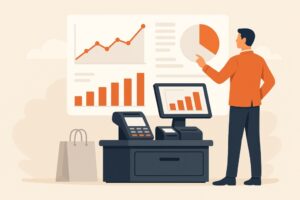Let’s be honest—running a business without data is like driving blindfolded. You can steer all you want, but where do you end up? That’s anyone’s guess.
Thankfully, there’s a simple tool many businesses already have (but rarely squeeze enough value from): their point of sale system.
It’s not just a glorified cash register anymore. Today’s POS systems quietly gather truckloads of useful information—if you know how to read it.
And if you’re not tapping into that? You’re probably leaving money on the table without even realising it.
What Exactly Is Point of Sale Analytics?
Every sale tells a story. Multiply that by a few hundred (or thousand) transactions, and you’ve got a goldmine of insights.
We’re talking sales patterns, product popularity, quiet hours, hot zones, and even which staff member sells the most add-ons.
Your POS isn’t just ringing up totals. It’s collecting behaviour, trends, and real-time data, ready to inform better decisions without needing a business degree or a crystal ball.
It’s like having a live feed of what’s working—and what’s not—right at your fingertips.
Better Inventory Without the Guesswork
Raise your hand if you’ve ever ordered way too much of something that just sat there… or worse, ran out of your top seller during a rush. Painful.
POS analytics track what’s selling and what’s gathering dust. You’ll know exactly when to restock, what to retire, and which items fly off the shelves only during certain months. This isn’t magic—it’s just smart, clean data doing its job.
No more guessing how many units to buy. Your POS has the receipts (literally).
It’s a simple shift that can save thousands and make your operations leaner without sacrificing choice.
Real Eyes on Staff Performance
It’s not about spying. It’s about understanding. Who’s selling the most during lunch rush? Who’s turning tables faster without cutting corners?
You can use POS data to spot trends in team performance, without awkward reviews or guesswork. This kind of transparency helps reward great work and identify where support or training might be needed.
Bonus? It builds trust. Staff know you’re looking at facts, not feelings.
It also gives managers something more concrete to coach from—no more vague “do better” conversations.
Promotions That Actually Work
So you tried 20% off everything last month… Did it help? Or did people just buy the same stuff they always do, but cheaper?
With POS analytics, you’ll know exactly how each promotion performed. What moved, what didn’t, and whether that discount paid off.
You can even time your offers better, like knowing people buy more wine after 5 pm on Fridays.
That’s a real trend you can act on.
Now, instead of blanket discounts, you’re crafting smart, strategic offers based on what works.
It’s the difference between spending on marketing and investing in it.
Understand Your Customers Like Never Before
You’ve got regulars. You’ve got one-off browsers. You’ve got that guy who only shows up for the monthly steak special. They all leave behind data.
Your POS helps you track what they buy, how often they visit, and how much they spend.
Over time, this info can help you personalise experiences, build loyalty programs, or just remember that Steve really loves the smoked salmon bagel.
That’s the kind of service that keeps people coming back.
And let’s face it—keeping a customer is a whole lot cheaper than winning a new one.
Data That Drives the Big Decisions
Here’s the thing—most businesses don’t fail because they work too little. They fail because they bet on the wrong things.
Should you open another location?
Hire more staff?
Change your pricing? Instead of crossing your fingers, look at the numbers.
Are weekend sales strong enough to justify staying open later?
Are profit margins shrinking even with more foot traffic?
These aren’t emotional decisions—they’re strategic ones. Your POS already has most of the answers, tucked away in transaction logs.
Let the data be your compass, not just your scoreboard.
Final Thoughts: Data You Can Use, Right Now
You don’t need a fancy dashboard, expensive consultants, or endless reports. Start by logging into your point of sale system and reviewing the basics: top-selling products, peak times, customer return rate, and discount impact.
From there, it’s all about experimenting, tweaking, and growing. Data doesn’t replace instinct—it sharpens it.
It gives you confidence in your choices. And sometimes, it saves you from learning things the hard (and expensive) way.
Use what you’ve got. Make it work for you. And never underestimate how much a simple sales report can teach you—if you’re paying attention.
The best insights might already be sitting in your sales history, just waiting to be noticed.

